
5 Ways PR Pros Can Use ChatGPT to Accelerate Their Work
PR pros in every single market need to pay attention to AI content generation tools. If you don’t figure out how to use them, you’re going to be replaced by them.
No, not now. Tools like ChatGPT are a long way from being able to engage in media relations—but they are lot closer than I would have guessed two months ago.
AIs may be closer to your job description than they appear. via GIFER
When I started seeing coverage of ChatGPT’s human-like language abilities, I didn’t feel threatened. I’m a storyteller, dammit! No mere algorithm can do what I do! But I’m also unafraid of the truth. Assuming I’m better at my job than ChatGPT isn’t enough: I had to verify. I gave ChatGPT a series of common PR tasks – and while I am way better at PR than ChatGPT, it’s a disturbingly competent assistant.
There are few ways PR and marketing pros can start using ChatGPT right now: but first, a few caveats. As OpenAI CEO Sam Altman has said, you can’t rely on ChatGPT for “anything important” yet. Here are a few of its known limitations:
- Pithy, it ain’t: ChatGPT’s responses tend toward long and repetitive. The more depth you ask for, the more repetition and circular logical construction you’re likely to see.
- It’s not exactly a trendspotter: ChatGPT doesn’t know much about current events past 2021, and its responses sometimes include outdated information. This may change when the Bing/ChatGPT integration comes to fruition; time will tell.
- It learned from watching us: ChatGPT’s responses can include factual errors, bias, nonsense that sounds like sense, and other unsettlingly human mistakes.
Because of these limitations (and some, at least to me, blindingly obvious ethical issues) there is no task that ChatGPT can just do for you. However, in all honesty, there are some tasks that ChatGPT can accelerate dramatically.
1. Writing Company Boilerplate
Of all the tasks I tested, ChatGPT was most successful at creating company boilerplate. I tried asking ChatGPT to write boilerplate for both real companies and an unnamed new organization. In both cases, the results were borderline usable.
Example 1 – Real Company
I first asked ChatGPT about a client that likely appeared in its training data, Vanco International. To be clear, ChatGPT didn’t just scrape Vanco’s 2021 boilerplate – it created something new.
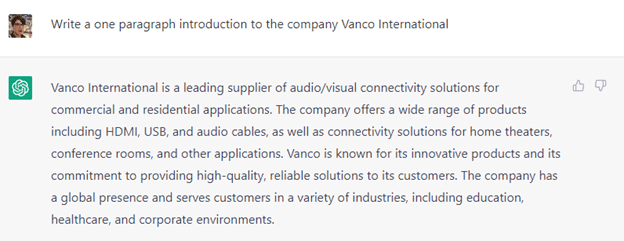
First of all, heck yeah: even a robot knows my client Vanco International is an innovative manufacturer of reliable, high quality AV technologies. They must have a great PR agency or something. Second of all, while this is missing some nuance and key details, it wouldn’t take that much polishing to get to a usable state.
Example 2 – New Organization
ChatGPT was also able to produce a reasonably legit-sounding boilerplate description of a new organization. I based this request on the Metaverse Standards Forum, a Caster client that didn’t exist as an entity in 2021. Because there was nothing in its training data about this organization, ChatGPT had to make up all the details, presumably drawing on the way people talk about similar organizations. The results are so realistic that frankly, they’ve made me more wary of clichés in my own writing.
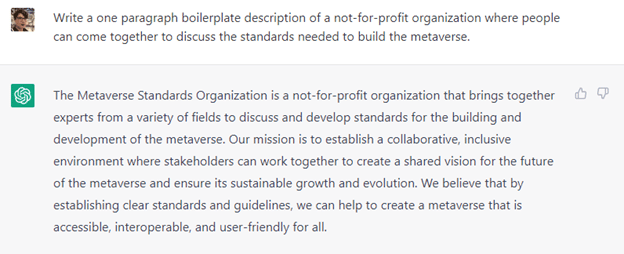
Verdict: I hate to say it, but ChatGPT is good at this task – and, because it allows the user to make corrections and provide follow-up information, you can easily refine results and produce alternate versions.
2. Writing an Outline
I know I should always write an outline before I draft an article or a blog. I know doing so will save me time and result in a better end product. Here’s the thing, though: I don’t wanna. So perhaps this is a task that can be quickly and efficiently automated?
Example

Not too shabby, ChatGPT! I could use an outline like this to help make a research plan, and it might even ultimately form a helpful skeleton for an article.
**However** I also tried using ChatGPT to outline this very blog, and the results were nowhere near as good. Turns out that, much like my mom, ChatGPT doesn’t really seem to know what PR pros do for a living. All of its suggestions were around using ChatGPT to support customer service functions.
Verdict: Worth a shot. Sometimes, ChatGPT produces a helpful outline that can focus your thinking and get you started on research or a piece of writing. Sometimes it produces gobbledygook. It takes you 30 seconds to check.
3. Tweeting
Twitter is mostly bots anyway, right? If you give ChatGPT a topic, it can draft a tweet for you, even going so far as to incorporate hashtags.
Example
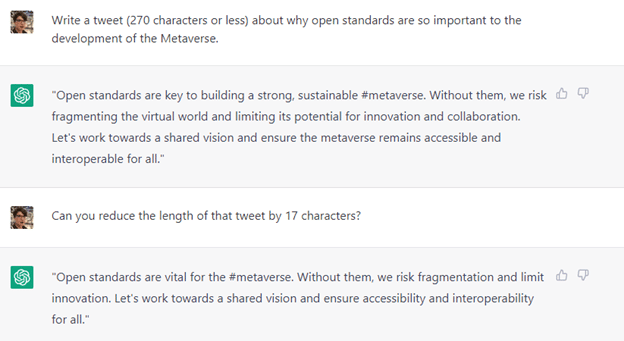
This is…okay, I guess, but in the context of social media, the bot-iness of ChatGPT really stands out. Boilerplate can be generic, but your voice on social media shouldn’t be.
Verdict: Personally, I’m going to avoid for now. It’s not much faster to give ChatGPT the instructions to draft a tweet than to it is to just…draft a tweet. Really, its best use right now is as a counter-example. If your social sounds too much like ChatGPT, it needs to get a life.
4. Technical Explanations
It’s often important to establish some clear concept definitions before you get to the meat of your story or pitch. This seems like the sort of basic, factual content that should be easy to automate, right?
Example
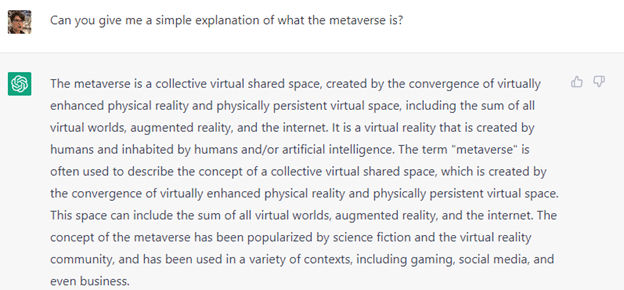
Remember when I said ChatGPT could get repetitive? Well, not to repeat myself, but YOWCH. The first four sentences in this paragraph contain essentially the same information, phrased in slightly different ways. It’s not wrong, just needlessly verbose.
Verdict: ChatGPT is usable for producing definitions and explanations, but you need the right mindset. Use it to produce a brief summary of a concept you’re already well familiar with. Often, it’ll give you several different options for phrasing in a single response. You might get something pithy and usable – I don’t hate “virtually enhanced physical reality and persistent virtual space” as a description of the metaverse – but whatever it produces must be fact-checked. What it doesn’t know, it will just make up.
5. Differentiating by Audience
When you ask ChatGPT to adjust its responses to different audiences, the results are neither useless nor strictly usable.
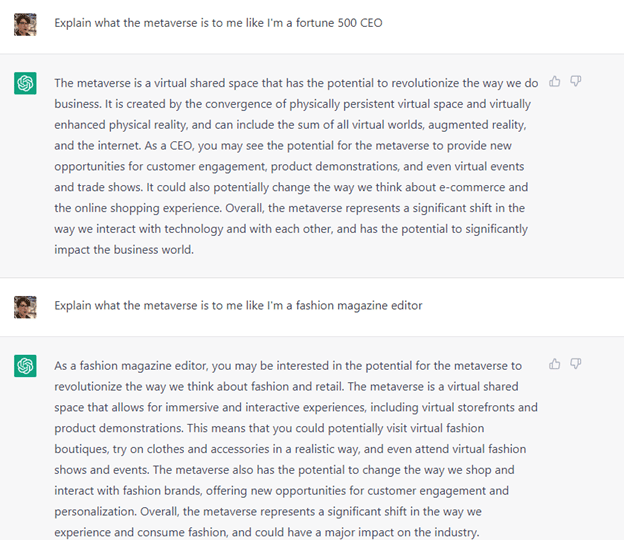
To me, these responses display big “How do you do, fellow kids?” energy: stilted and obviously fake. There are some useable points buried in here, though.
In fairness, when I asked ChatGPT to describe its own limitations, it told me that “it is not capable of understanding the context or intended audience of the text it generates…This can lead to outputs that lack nuance, empathy, or appropriateness for the intended audience.”
Verdict: While I wouldn’t let ChatGPT draft a pitch, I might let it help me brainstorm ideas for differentiated talking points by vertical. In this case, it could be a useful mechanism to kickstart your own creative process. Then, it’s up to you to bring the personalization, nuance, empathy, and audience-appropriate context to the task.
Right now, ChatGPT is like an overconfident PR intern. It will dive into any task without asking follow-up questions, and produce results that range from surprisingly useable to complete nonsense. It needs to be heavily supervised. However, like an intern, it’s learning all the time. It’s going to get better at everything it’s asked to do. In fact, like a true go-getter, it may already be helping you without even being asked. News broke earlier this week that Microsoft is already using an earlier version of OpenAI GPT to support Office auto-complete functions, and it experimenting with more robust ChatGPT integration.
In the AI era, your value as a PR pro will no longer derive from your ability to churn out copy. It will derive from your ability to design a communications strategy and identify the right tactics for any given moment; to not just respond to existing data, but to predict and even create new trends; and to communicate with empathy, humor, and a personal touch. If you are spending the bulk of your hours doing tasks that can be automated, you’re eventually going to be replaced by automation. In the very near future, you’re going to have to let the robots handle all the easy stuff and spend your time doing only the hardest and most interesting parts of your job.

